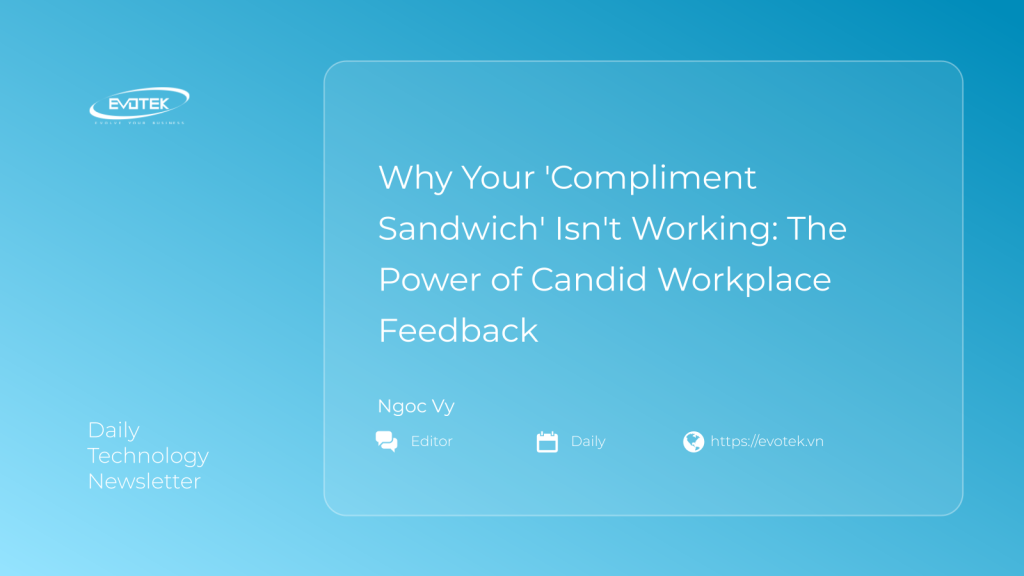Delivering constructive criticism is often seen as one of the most challenging managerial tasks. While essential for employee development, team cohesion, and leadership confidence, the practice of providing tough feedback often falls short of its potential. For decades, a popular method to soften the blow has been the “compliment sandwich.” However, new research suggests this widely adopted tactic is now stale and ineffective.
The “compliment sandwich” involves layering negative feedback between two positive, often unrelated, comments. A typical example might be: “Roger, your insights at the client meeting were invaluable (compliment). However, your punctuality has declined, impacting deliverables (feedback). But that last report you drafted was exceptional (compliment).” This approach, popularized in the 1980s, aimed to mitigate discomfort for both the giver and receiver of feedback.
According to Karen MacMillan, a professor of organizational behavior at Ivey Business School at the University of Western Ontario, this method no longer holds up. “It was once the gold standard,” MacMillan states, “but the research is clear—layering compliments doesn’t make tough feedback any easier to swallow.” Instead of fostering growth, it frequently creates confusion and distrust.
Honesty Over Artificial Harmony
MacMillan, along with Ivey research partners Fernando Olivera and Cameron McAlpine, and Gouri Mohan from IESEG School of Management, has been exploring the critical role of candor in the workplace. Their early findings indicate that honest, open communication, when executed correctly, yields significant benefits.
“When practiced with kindness, candor has wide-reaching benefits,” MacMillan explains. Direct feedback, delivered with care and confidence, not only aids employee development but also strengthens professional relationships and builds foundational trust. This is precisely where the traditional compliment sandwich falters. Employees often perceive the initial positive remarks as mere buffers, anticipating the inevitable “but” and the negative comment that follows. This pattern can lead to recipients ignoring genuine positive feedback and resenting the criticism.
“They’re waiting for the other shoe to drop,” MacMillan notes. “Regularly starting with a compliment to ease into a critique quickly teaches people to be on high alert. They end up ignoring the positive and resenting the negative.”
A Roadmap for Effective Feedback
For leaders ready to move beyond outdated feedback methods, MacMillan offers a practical, intention-driven roadmap for more meaningful conversations:
1. Strategize Your Approach
Many feedback missteps occur due to lack of preparation. Before any discussion, take a few moments to ask yourself:
- What is the core purpose and goal of this feedback? Am I acting with the right intentions?
- Do I have specific, concrete examples to support my observations?
- Can I clearly articulate the impact of the behavior in question?
- What will be my opening line? “That first sentence sets the tone,” MacMillan emphasizes. “It can make or break the conversation.”
2. Foster a Dialogue
Avoid a monologue. Effective feedback is a two-way street. Be prepared to ask open-ended questions like, “How do you perceive the situation?” or “Are we seeing this similarly?” This creates space for the employee to share their perspective, potentially revealing crucial information you might be missing. If the conversation drifts, it’s acceptable to pause, redirect, or even reschedule.
3. Demonstrate Personal Investment
Show that you care about the individual’s success by linking your feedback to their aspirations. For instance, you might say, “I know you’re eager to advance within the company. I’ve observed something that might be hindering your progress. Would you like to discuss it?” This approach empowers the employee, shifting from a top-down directive to a collaborative effort.
4. Achieve Mutual Agreement
Every feedback conversation should conclude with clarity. Establish a clear plan, outlining next steps and when you will follow up. Even a simple statement like, “Let’s both reflect on this and reconnect next week,” helps maintain momentum and accountability.
5. Embrace Feedback as an Ongoing Process
Significant change rarely results from a single conversation. Real improvement is achieved through a continuous process of follow-up, reinforcement, and building trust over time.
While adopting candid feedback requires courage initially, MacMillan assures that with practice, these honest conversations become more natural, more impactful, and ultimately more rewarding for everyone involved. “The real measure of feedback isn’t how well it’s delivered,” she concludes, “it’s whether it creates change and strengthens relationships.”

 日本語
日本語 한국어
한국어 Tiếng Việt
Tiếng Việt 简体中文
简体中文